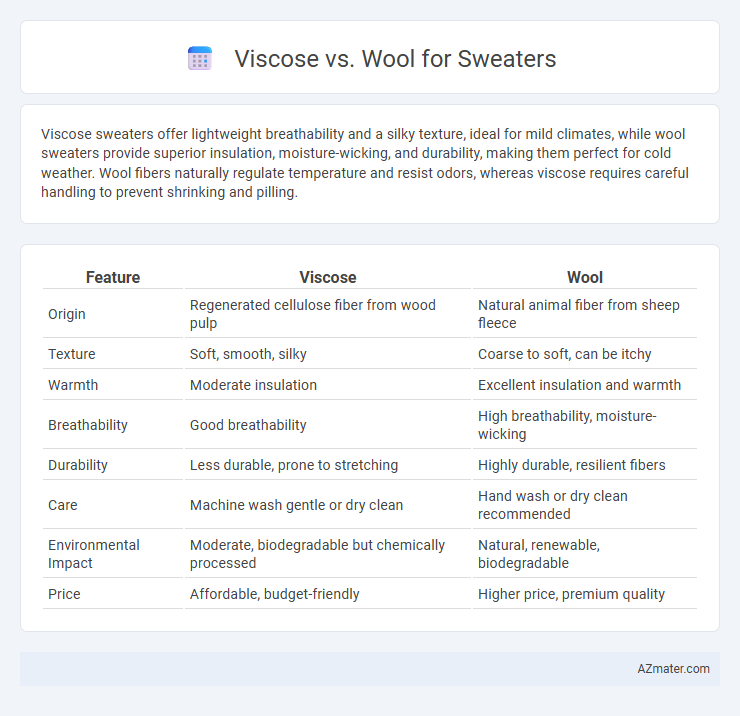Viscose sweaters offer lightweight breathability and a silky texture, ideal for mild climates, while wool sweaters provide superior insulation, moisture-wicking, and durability, making them perfect for cold weather. Wool fibers naturally regulate temperature and resist odors, whereas viscose requires careful handling to prevent shrinking and pilling.
Table of Comparison
| Feature | Viscose | Wool |
|---|---|---|
| Origin | Regenerated cellulose fiber from wood pulp | Natural animal fiber from sheep fleece |
| Texture | Soft, smooth, silky | Coarse to soft, can be itchy |
| Warmth | Moderate insulation | Excellent insulation and warmth |
| Breathability | Good breathability | High breathability, moisture-wicking |
| Durability | Less durable, prone to stretching | Highly durable, resilient fibers |
| Care | Machine wash gentle or dry clean | Hand wash or dry clean recommended |
| Environmental Impact | Moderate, biodegradable but chemically processed | Natural, renewable, biodegradable |
| Price | Affordable, budget-friendly | Higher price, premium quality |
Introduction to Viscose and Wool
Viscose, a semi-synthetic fiber derived from cellulose, offers a smooth, silky texture and excellent breathability, making it a popular choice for lightweight sweaters. Wool, a natural fiber harvested from sheep, provides superior insulation, moisture-wicking properties, and durability, ideal for cold-weather garments. Understanding the key differences in fiber origin and fabric performance helps in selecting the right material for sweater comfort and functionality.
Key Differences Between Viscose and Wool
Viscose is a semi-synthetic fiber made from cellulose, offering a silky texture and excellent breathability, while wool is a natural fiber derived from sheep, known for its superior insulation and moisture-wicking properties. Viscose sweaters tend to be lightweight and drape well, making them ideal for mild weather, whereas wool sweaters provide warmth and durability, suitable for colder climates. Wool also has natural elasticity and odor resistance, contrasting with viscose's tendency to wrinkle and require gentle care.
Comfort and Softness Comparison
Viscose sweaters offer a smooth and silky texture that feels lightweight and breathable against the skin, making them ideal for mild weather comfort. Wool sweaters provide superior warmth and natural insulation with a slightly coarse texture, which can sometimes cause itchiness for sensitive skin. Choosing between viscose and wool hinges on personal preference for softness and thermal comfort, with viscose excelling in softness and wool prioritizing warmth.
Warmth and Insulation Properties
Wool offers superior warmth and insulation due to its natural crimp and moisture-wicking fibers that trap heat effectively, making it ideal for cold weather sweaters. Viscose, being a semi-synthetic fiber derived from wood pulp, provides softness and breathability but lacks the thermal insulation properties found in wool. Sweaters made from wool maintain heat better in damp conditions, while viscose sweaters are more suitable for mild climates where lightweight comfort is preferred.
Durability and Longevity
Viscose sweaters offer moderate durability but tend to weaken with frequent washing and wear, making them less suitable for long-term use compared to wool. Wool sweaters provide superior longevity due to natural resilience, elasticity, and resistance to abrasions, maintaining shape and warmth over years. Investing in wool ensures a durable garment that withstands everyday wear and repeated cleaning better than viscose alternatives.
Breathability and Moisture Management
Viscose offers moderate breathability and absorbs moisture well, making it suitable for lightweight sweaters in mild climates. Wool excels in moisture management by wicking sweat away from the skin and retaining warmth even when damp, ideal for cold or variable weather. Wool's natural fibers allow superior air circulation and temperature regulation, ensuring better comfort during extended wear compared to viscose.
Maintenance and Care Requirements
Viscose sweaters require gentle hand washing or dry cleaning to prevent fabric weakening and maintain softness, while wool sweaters need careful hand washing with cold water or professional dry cleaning to avoid shrinkage and felting. Wool demands periodic airing to retain freshness and natural lanolin to preserve fiber elasticity, whereas viscose benefits from low-heat ironing and avoiding prolonged exposure to moisture. Both fabrics should be stored in a cool, dry place but wool sweaters often require moth repellent due to their protein fiber composition.
Environmental Impact and Sustainability
Viscose production involves high water consumption and chemical use, contributing to deforestation and pollution, making its environmental impact significant compared to wool. Wool is a renewable resource harvested from sheep, biodegradable, and supports biodiversity when managed responsibly, promoting sustainability in textile production. Sustainable wool options include certifications like Responsible Wool Standard (RWS), which ensure animal welfare and land management best practices.
Price and Accessibility
Viscose sweaters generally offer a more affordable price point compared to wool, making them accessible to budget-conscious shoppers. Wool, known for its natural insulating properties, tends to be pricier due to sourcing from sheep and processing costs. Availability of viscose is widespread in fast fashion and mass-market stores, whereas high-quality wool sweaters are often found in specialty or premium retail outlets.
Choosing the Right Material for Sweaters
Viscose offers a smooth, silky texture and excellent breathability, making it ideal for lightweight sweaters that are soft against the skin. Wool provides superior insulation, moisture-wicking properties, and durability, perfect for warmth and longevity in colder climates. Choosing between viscose and wool depends on the desired sweater weight, climate, and comfort preferences, with wool excelling in thermal regulation and viscose favored for a lighter, more breathable feel.

Infographic: Viscose vs Wool for Sweater
 azmater.com
azmater.com